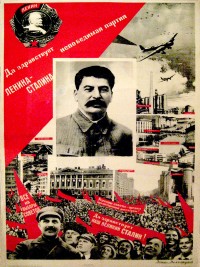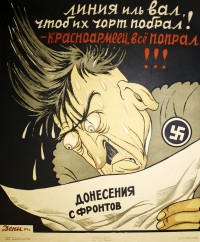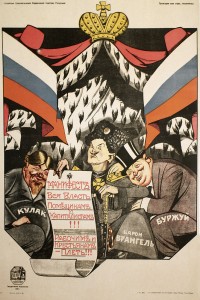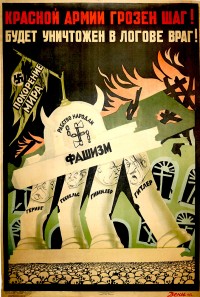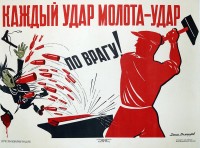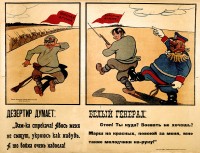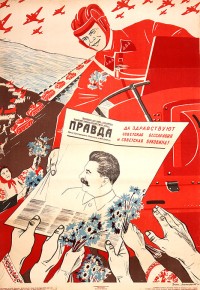Deni (Denisov), Viktor Nikolaevich
Born 1893, Moscow, Russian Empire; died 1946, Moscow, USSR
Although known for his characterizations and posters that he signed with the pseudonym 'Deni'; Viktor Nikolayevich Denisov never received formal artistic education. Around 1906, Deni began exhibiting at the annual exhibitions of the Society of Independents in Saint Petersburg, as well as at the Salon of Humorists. In 1910, he took private lessons in painting and drawing from the artist-portraitist Nikolai P. Ulianov and that same year, he became active in the field of political caricature, contributing satirical drawings to such journals as Budil'nik [Alarm Clock], Satiricon, Solntse Rossii [Russian Sun], Pulemet [Machine Gun], Knut [Whip], while contributing to the newspaper Golos Moskvy [Voice of Moscow]. After the October Revolution of 1917, Deni worked for Litizdat (State Publishing House). During the early post-Revolutionary period, he lived in Kazan' and produced his first posters there while continuing to work on political caricatures for a myriad of Soviet journals.
Upon his return to Moscow in 1920, he contributed to the ROSTA (Russian Telegraph Agency) Windows studio creating posters for the collective. By 1921, his caricatures appeared in newspapers, including the main Soviet news organ Pravda [Truth]. His posters were included in a number of high-profile exhibitions such as Krasnaia armia [Red Army] (1923) and Raboty na revoliutsionnye i sovetskie temy [Works of Revolutionary and Soviet Themes] (1930). He also exhibited works at international fairs in Berlin, Hamburg, Vienna, and Amsterdam, and he was an exhibitor at the International Poster Exhibition in Liege (1932). In 1932, Deni was awarded the title of Honored Worker of the Arts of the Russian Soviet Federated Socialist Republic.
During World War II, he produced an extensive series of accusatory cartoons against the German invasion of the USSR. In July 1943, he designed posters for the TASS (Soviet Telegraph Agency) Studio. His works are included in private and institutional collections around the world, including holdings in the State Tretyakov Gallery, the State Russian Museum, and the Russian State Library.
Fuentes
Zegers, P., et al. (2011). Windows on the war: Soviet TASS posters at home and abroad, 1941-1945. Chicago: Art Institute of Chicago. (A biography of the artist is in this book)
Bonnell, V. E. (1999). Iconography of power: Soviet political posters under Lenin and Stalin. Berkeley: University of California Press. (pp. 71, 190, 196, 209, 214, 222)
White, S. (1988). The Bolshevik Poster. New Haven: Yale University Press. (pp. 55-60)
Butnik-Siverskii, B. S. (1960). Sovetskii plakat epokhi grazhdanskoi voiny, 1918-1921. Moskva: Izd-vo Vsesoiuznoi knizhnei palaty. (pp. 57, 63, 66, 137, 139)
Sviridova, I. A. (1958). Deni. Moskva: Sovetskii khudoznik. (book about the life and career of Deni)
Baburina, N. I. (1988). The Soviet Political Poster, 1917-1980. New York: Penguin. (bio, artist)
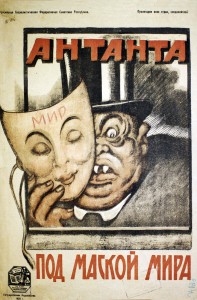
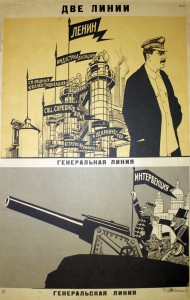
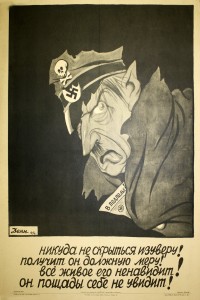
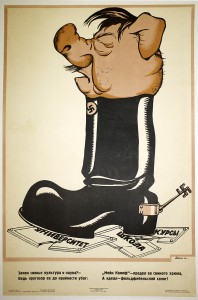
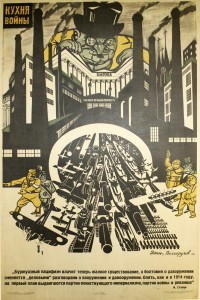
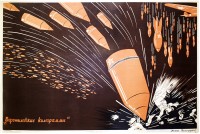
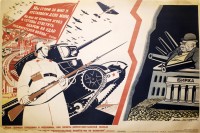
![PP 463: Gastos totales para el año 1932.
21.000.000.000 de rublos
[Traducción parcial]](https://www.posterplakat.com/thumbs/the-collection/posters/pp-463/pp463-200x275.jpg)
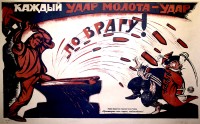
![PP 540: ¡Vivan los orgullosos halcones de nuestra patria, oficiales de Stalin, valientes pilotos, que no conocen barrera alguna a la hora de cumplir con el objetivo establecido!
¡Nuestros más cordiales saludos a las heroicas hijas del pueblo soviético –
¡Valentina GRIZODUBOVA, Polina OSIPENKO y Marina RASKOVA!”
[Traducción parcial]](https://www.posterplakat.com/thumbs/the-collection/posters/pp-540/pp540-200x142.jpg)
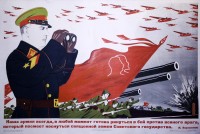
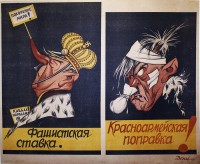
![PP 653: Results of the First Five-Year Plan.
[Partial translation]](https://www.posterplakat.com/thumbs/the-collection/posters/pp-653/pp653-200x267.jpg)
![PP 663: Long live the Red Army, the keen-eyed watchman of Soviet borders. Strengthen the defense of the USSR!
The intervention of 1918 and 1919:
Kornilov [White Army General]
Kaledin [Kossack Commander]
Krasnov [White Army Cavalry General]
[Partial translation]](https://www.posterplakat.com/thumbs/the-collection/posters/pp-663/pp663-200x280.jpg)
